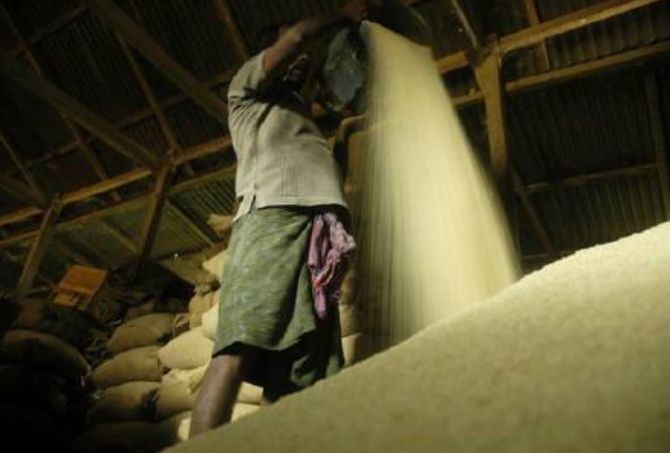 | « Back to article | Print this article |
In the European countries, one of the pivotal issues is quality control. Once a product is granted GI there is little possibility of fakes, which is not the case in India

Be it ‘Basmati Rice’, or ‘Darjeeling Tea’ or ‘Hyderabadi Biryani’, getting a Geographical Indication tag (GI) for items exclusive to India has been a contentious issue.
Though Geographical Indications of Goods (Registration and Protection Act), enacted in 2003, has brought the much-needed transparency and clarity into the entire field, a lot of confusion and complications still remain, say experts.
These originate primarily due to lack of quality control once the tag is obtained and also limited hand-holding prior to applications being made to the Registrar, leading to half-baked attempts to seek a GI certification.
Darjeeling tea became the first GI-tagged product in India, in 2004–05. Since then over 300 goods have been added to the list.
India’s vast and vibrant agricultural and food varieties along with inter-regional variations also make it a ‘nightmare’ while applying for GI.
The latest case in point is Madhya Pradesh’s claims of GI tag for the basmati grown in the state and also its dispute with neighboring Chhattisgarh for ‘kadaknath’ chicken (a particular black chicken breed grown largely in tribal areas of the state).
The GI Registry on March 15 rejected the Madhya Pradesh government's claim over GI tag for basmati rice. The state has challenged the order in the Madras high court.
It has contended that the order should be set aside since it "relies on an extraneous and non-statutory metric such as popular perception to dismiss the case for GI tag".
The state’s Basmati Growers Association too joined the government in challenging the order of the GI registry.
In May 2010, GI status was granted to basmati grown only in Punjab, Haryana, Delhi, Himachal Pradesh, Uttarakhand and parts of western Uttar Pradesh and Jammu and Kashmir.
Madhya Pradesh was excluded from the list. The state then moved an application that rice grown in its 13 districts should also be considered ‘basmati’ as these districts have been growing this variety for several decades and its qualities was similar to the rice grown in Indo-Gangetic plains.
Madhya Pradesh’s opponents contend that granting GI tag to basmati grown everywhere will lower its market value and the rice would stop commanding premium in the world market.
Even as the case relating to basmati GI is pending in courts, Madhya Pradesh got a big respite when the GI Registry recognised ‘kadaknath’ chicken grown in the state as the real one rejecting neighboring Chhattisgarh’s claim on the variety.
‘Kadaknath’ is an indigenous black-feathered chicken breed found in tribal-dominated Jhabua district in the state.
The application for GI tag was filed by Madhya Pradesh in 2012.
Chhattisgarh contested the GI claims on the grounds that the chicken belonged to Dantewada district in the state, where several women-led Self Help Groups (SHGs) have been cultivating it for decades. The GI Registry rejected its claims.
Kadaknath Chicken, which is one of the rarest poultry breeds of India, is famous for its black meat, low cholesterol, high protein, quality, texture and taste. It is sold at over Rs 500 per kilogram.
Post-the GI tag, sources said its price in the market has zoomed and in some cases crossed even Rs 1000 a kg.
“A factor in granting a GI tag for any product is ‘public perception’ about the same. This is easier for products which are associated with a particular area like Darjeeling Tea, Champagne of France, but when it comes to generic items like Pashmina which is not usually associated with a particular area or region by the virtue of its name, granting a GI becomes highly challenging,” said Rajendra Kumar, senior partner at K&S Partners, one of the leading firms dealing with GI related issues.
He said GI Act and its implementation in India is relatively new - it started from 2003 onwards - while in other countries the concept has been in existence for long.
The other big challenge in getting GI in India, experts said is the improper filing and lack of knowledge which sometimes leads to half-baked applications being filed increasing their chance of rejection by competent authorities.
Latha Nair, partner in K&S Partners said there are no provisions for quality control in the GI Act once GIs are registered, which is why there is proliferation of applications in India.
“In the European countries, one of the pivotal issues is quality control. Once a product is granted GI there is little possibility of fakes, which is not the case in India,” Nair said.
A GI tag brings its own brand equity for the product and it commands premium in the market, but to get that a lot of background work needs to go into before a formal application is made, something which is absent in India leading to higher number of rejections.
A case in point is ‘Hyderabadi Biryani’ which failed to get the GI tag as the applicant for it could not prove the historical origin and data relating to dish with supporting documents.
The application was filed by Deccani Biryani Makers Association (DBMA) a few years back.
“In India there is urgent need to have a body which can guide or handhold all GI applicants as to what is required and how the process could be mastered or else rejections would continue to be high given the diverse number of products and cuisines and process that India possesses, unmatched by many countries globally,” another expert said.
Photograph: Jayant Dey/Reuters